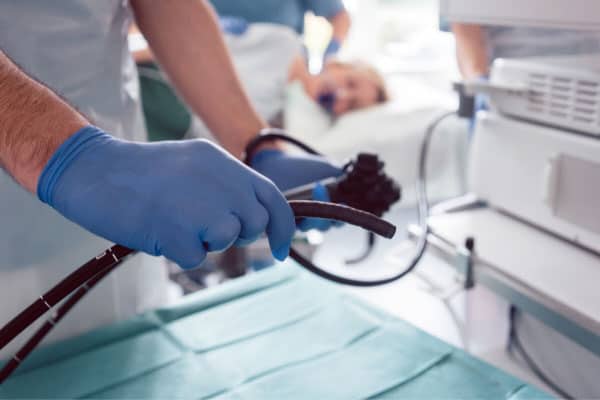In the UK, endoscopies are the most performed gastrointestinal procedure, with around two million procedures performed each year. Explore our guide to the different types of endoscopy to understand more about the procedure.

What is an endoscopy?
An endoscope is a long, thin, flexible tube that has a light and camera at the end for doctors to see the inside of your body on a television screen.
Endoscopes are either put through the mouth and down the throat or through the bottom. Some endoscopic procedures are done through keyhole surgery whereby a small incision is created to allow access to the abdomen and female pelvic organs, this is also known as a laparoscopy.
They can also be used to remove a small sample of tissue to be examined under a microscope, this is known as a biopsy.
An endoscopy can detect disease in several parts of the body, including:
- Digestive system – digestive tract, bowel, esophagus stomach and duodenum
- Respiratory system – bronchial tubes and lungs
- Urinary system – bladder
- Reproductive system – uterus, cervix and prostate
- ENT – nasal passage, sinuses and throat
- Joints
Symptoms that you might need an endoscopy:
- if you are having difficulty swallowing (dysphagia)
- tummy pain that does not go away or keeps on coming back
- diarrhoea and feeling or being sick often
- unintentional weight loss
- regularly experiencing heartburn or indigestion
- blood in your poo
Endoscopic surgery types
There are several different types of endoscopies to check different areas of the body.
- Gastroscopy: investigating the oesophagus, stomach and top part of the small intestine
- Colonoscopy: if you are experiencing bleeding from your bottom, constant diarrhoea or constipation, losing weight or feeling really tired – you may need your bowel examined
- Flexible sigmoidoscopy: is when a doctor needs to look at the lower part of the bowel
- Bronchoscopy: if you are coughing up blood or have a cough that is not getting better
- Hysteroscopy: for problems such as irregular periods or if you have had a miscarriage more than once, a hysteroscopy looks inside the womb (uterus)
- Cystoscopy: if you are experiencing urinary incontinence or blood in your pee you may need a cystoscopy to look inside your bladder
- Endoscopic ultrasound: allows doctors to take images of internal organs like the pancreas, as well as take tissue samples
- Wireless capsule endoscopy: is when you swallow a small capsule that has a camera and light source on it, which sends pictures to a screen
Preparing for an endoscopy
Before having an endoscopy, make sure your doctor is aware of any medical conditions you have and don’t be afraid to ask them any questions about how to prepare and what happens during the procedure.
Doctors may ask you to avoid eating and drinking for several hours before your endoscopy, this is to avoid any complications.
Depending on the type of procedure you are having, you may need be given laxatives to use the night before your procedure to help clear up your bowels. You may also be asked a few days before to eat a low-fibre diet.
Some patients may have to take antibiotics to help avoid infections. Also, if you take medicines such as warfarin or clopidogrel that thins your blood, you may need to stop taking it for a few days to avoid running the risk of bleeding during the procedure.
To help you relax:
- wear comfortable clothes that are not too tight
- arrange how you’re going to get home in case you’re feeling uncomfortable afterwards or if the procedure requires you to have sedatives
- plan enough time to recover after your operation in case you feel any discomfort
During the procedure
Endoscopies don’t tend to cause you any harm, although can be quite uncomfortable.
The procedure usually takes place when you’re awake. You may be given a local anaesthetic to numb a specific part of your body or offered a sedative to help you relax and make you less aware of what is going on.
The procedure will begin with the endoscope carefully put into your body and can take 15 – 45 minutes. You can usually go home the same day and do not need to stay overnight in hospital.
Endoscopy risks
Endoscopies have a low risk rate, although some of the rare complications include infections which may require antibiotic treatment and piercing, tearing or bleeding of an organ, which you may need surgery to repair.
Signs of an infection include:
- redness, pain, or swelling where the endoscope was inserted
- discharge or pus near where the endoscope was inserted
- a high temperature and feeling hot or shivering
If you were sedated during your procedure you may experience side effects such as feeling nauseous or being sick, bruising or burning where you were injected, low blood pressure or breathing difficulties.
Other complications can include:
- black or very dark-coloured poo
- shortness of breath
- very bad tummy pain, or tummy pain that does not go away or keeps coming back
- vomiting blood
- chest pain
- difficulty swallowing
If you experience any of these symptoms after your surgery visit your GP or visit your nearest A&E immediately.

